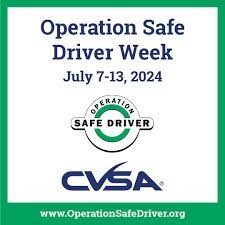This crazy weather continues this year, and the heat is setting record temperatures across North America.
For drivers to operate a commercial motor vehicle (CMV) safely, they also need to understand how heat affects the operation of the CMV. Areas that drivers must pay attention to during their inspections include the engine coolant, Diesel Exhaust Fluid, and tires!
Engine Coolant
Approximately 10 years ago, OEM truck manufactures introduced extended life coolant (ELC) into the industry! With each EPA change, the operating temperature of the engine has increased by 10 to 15 degrees. It is estimated that 50% of all engine failures are associated with the overheating condition of the engine.
With today’s emission systems, an engine running low on coolant runs the risk of damaging emission components such as the exhaust gas recirculation (EGR) system.
The benefit of using ELC is that it can improve the engine's heat transfer rate by 12 to 13 percent over conventional anti-freeze.
Diesel Exhaust Fluid DEF
There is a quality level sensor in the DEF tank that can be affected by extreme heat. It is recommended that you keep the DEF tank full as possible to keep the sensor cool in extreme heat conditions.
During the pre-post trip inspection driver should:
- Make sure that the coolant level is within the range of the marking on the side of the coolant reservoir.
- If the coolant level is low, contact your Idealease service provider immediately for directions. ELC coolant should be red/orange in color and free of dirt, debris, rust, and other contaminants.
Do NOT mix ELC with conventional anti-freeze!
- If, when operating a CMV, a dash light comes on with an overheat warning, immediately pull the unit into a safe parking place, and contact your Idealease service provider for directions. Operating the unit in an overheating situation can severely damage the engine.
Tires
During the summer season, when the ambient temperatures can exceed 100° F and some road temperatures can reach almost 200° F, heat problems caused by underinflation become more severe. Underinflated tires are much more likely to fail under these conditions. A famous tire engineer once stated, “Heat is to tires as Kryptonite is to Superman” … in other words, it is their worst enemy. When you combine, hot summer temperatures, underinflated tires, heavy loads, and traveling at high speeds (not that this ever happens), you have a recipe for tire disaster…. That is exactly why you see more alligators on the highway in the summer season.
What can drivers do to minimize tire related issues during the summertime months?
- Tire pressures need to be checked more frequently in the summer.
- Tire pressures need to be checked when the tire is “cold” and not after operation. Pressures can increase during operation when “hot” by as much a 15% giving you a false reading.
- Inspect tires for punctures and damage during pre-post trip inspections and stops. Tire punctures tend to increase during the summer because the tread rubber becomes hotter and “softer” and acts as a magnet to nails and road debris.
- Immediately report tire conditions that need attention to your Idealease service provider.
Unintended Consequences of Tire Temperatures:
- Normal operating temperatures 100-150 degrees F
- Impact of another component on the tire 200-300 degrees F
- Flammable vapors start to form when the tire reaches 500-550 degrees F
- Burning at 650-700 degrees F
- Spontaneous combustion 850-900 degrees F
Heat and your employees
What are you doing to protect your employees from Heat Stroke and exhaustion?
These conditions are created when our body is unable to regulate our heat production at a safe level. First, we need to make all our employees aware of the signs and symptoms for these conditions:
- Fatigue, weakness, fainting
- Nausea and vomiting
- Headache
- Dizziness
- Muscle cramps
- Irritability
- Sweating (absence or presence)
- Paleness
These conditions can be further escalated by the physical condition of your employees.
Employees at a greater risk for heat exhaustion and heat stroke are those with: Heart disease, Skin diseases, Extensive burns, Endocrine disorders (hyperthyroidism, diabetes, etc.), High blood pressure, Overweight, Depression, Insomnia and Fever. Over the counter drugs can also contribute to a greater risk for these conditions.
All Heat- Related Illnesses are Preventable
What can you do to prevent them?
- Use Common Sense!
- Limit your exposure to direct sunlight as much as possible.
- Drink more fluids (non-alcoholic); avoid beverages containing caffeine or substantial amounts of sugar. Sports drinks are beneficial as they replenish electrolytes and salt in your body. Avoid extremely cold fluids, as they can cause stomach cramps. Drink often throughout the day, about 4-6 ounces at a time. WATER IS GOOD!
- Wear lightweight, light-colored, loose-fitting clothing that does not create a safety hazard for your work environment. If outdoors, wear a hat to reduce direct exposure to the sun.
- Make sure your employees are wearing sunglasses that provide UV protection and are impact resistant
- Avoid hot foods and heavy meals. They add heat to your body.
- Drivers on routes should pack a cooler with water for the day. Additionally, keep an umbrella in the truck, especially if operating in extreme conditions such as desolate or desert areas. This will allow you to move to an area with breeze and still be protected from the sun.
- If exposure to the sun is inevitable, apply generous amounts of sunscreen with a high SPF rating to exposed skin.
- Ensure your truck is in excellent condition. A thorough pre-trip inspection is crucial in extreme heat conditions to prevent breakdowns, otherwise, you may find yourself and your unit on the side of the road exposed to the extreme heat.
CVSA’s Operation Safe Driver Week Is Scheduled for July 7-13
The Commercial Vehicle Safety Alliance (CVSA) has announced July 7-13 as the dates for this year’s Operation Safe Driver Week, an initiative aimed at promoting safe driving through enforcement and outreach efforts. Law enforcement personnel in Canada, Mexico, and the U.S. will focus on identifying and addressing unsafe driving behaviors among commercial motor vehicle and passenger vehicle drivers, including speeding, distracted driving, following too closely, and impaired driving.
The primary focus of this year’s Operation Safe Driver Week is reckless, careless, or dangerous driving. Reckless driving refers to operating a vehicle with willful or wanton disregard for the safety of persons or property, while careless or dangerous driving involves operating a vehicle without due care and attention or reasonable consideration for other on the road. Enforcement actions during this week may include warnings or citations for drivers engaging in such behaviors.
CVSA’s Brake Safety Week Scheduled for Aug. 25-31
The Commercial Vehicle Safety Alliance (CVSA) has announced Aug. 25-31 dates for this year’s Brake Safety Week.
Brake Safety Week is a commercial motor vehicle and driver inspection and regulatory compliance enforcement initiative. It serves as both a brake-safety awareness and outreach opportunity and a brake-related inspection and violation data-collection project.
Inspection and Enforcement
CVSA-certified inspectors will conduct routine commercial motor vehicle inspections throughout the week, focusing on brake systems and components. Commercial motor vehicles found to have brake-related out-of-service violations will be removed from roadways until those violations are corrected.
For this year’s Brake Safety Week, inspectors will focus on the condition of brake linings and pads. Brake lining and pad issues may result in vehicle violations and affect a motor carrier’s safety rating.
In addition, some jurisdictions have performance-based brake testers (PBBTs) and will use them during Brake Safety Week. A PBBT is a machine that assesses a vehicle's braking performance.











